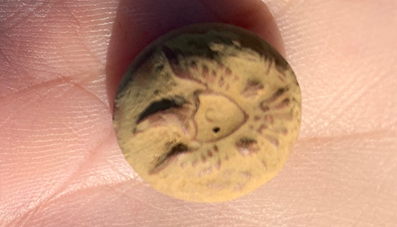(October 18, 2019) – In 1862, thousands of troops camped on and marched through farm fields throughout Frederick County. Today a team of archaeologists is using high-tech equipment to pinpoint troop movements throughout the county to unearth artifacts buried beneath the ground for over 150 years. Archaeologists will also investigate nearby yards to learn more about the people who lived in Burkittsville during the 18th and 19th centuries.
"There is no better way to discover more about Maryland's rich history than by exploring its five Civil War Trails, which follow the footsteps of the courageous soldiers who fought to preserve the Union,” said Governor Larry Hogan. “Finding and identifying these historic artifacts will help future generations of Marylanders connect to our state's historic roots.”
This month, Maryland Department of Transportation State Highway Administration (MDOT SHA) archaeologists joined Burkittsville Preservation Association and Preservation Maryland in a study of the South Mountain Battlefield. They plan to identify camps and battlefield lines and link them to roads that were used to move equipment during the Battle of South Mountain. Using old maps and metal detectors, archaeologists located evidence of the Civil War, including lead ammunition called Minié Balls and a Union cavalry button.
“This project will help to further identify and mark the important and nationally significant events that took place on these hills over 150 years ago,” Preservation Maryland Executive Director Nicholas Redding said.
“Once we link these battlefield lines to our modern road system, we’ll be able to determine how troops and equipment moved across the landscape,” MDOT SHA Chief Archaeologist Dr. Julie Schablitsky said. “Burkittsville is steeped in history and this is an amazing opportunity to learn more about the impact the war had on the town and its citizens.”
(MDOT SHA photo: Archaeologists Unearth a Minie’ Ball on South Mountain in Frederick County.)

(
MDOT SHA photo:
Archaeologists Find a Union Cavalry Button on a farm in Burkittsville.)
The team is examining the Hamilton Willard Shafer Farm - which was transformed into a Civil War camp in 1862 - and the Arnold Farm, where Confederate and Union soldiers exchanged fire.
The Shafer Farm’s brick house, summer kitchen, and stone outbuilding were standing during the Civil War. The farm produced grains and dairy products for the market, and prior to emancipation, this work was a task that more than a dozen enslaved African Americans handled. Archaeologists are also working to find evidence of their lives on these farms.
Revolutionary War Capt. Joshua Harley, the founder of Burkittsville, once lived at the Arnold Farm. The property consists of a Greek Revival style home that dates to 1790, along with a springhouse, a barn and stone walls that enclose pastures and fields at the base of South Mountain at Crampton’s Gap. During the Civil War, David Arnold operated the farm and stories exist of women baking pies for Confederates staying at the house and later, Union sharpshooters firing from the barn on Confederates up the hill.
Former Mayor of Burkittsville, Paul Gilligan, owns the Arnold Farm and is excited to have the archaeologists studying his property. “I have always wondered what the soldiers left behind. Now, it looks like we are finally going to find out” he said.
The public archaeology day will be hosted by MDOT SHA Archaeologists, Preservation Maryland, and members of the Burkittsville Preservation Association.
PUBLIC DAY Saturday, October 19, 2019
TIME: 12:30 p.m.- 3:30 p.m.
ADDRESS: 1606 Gapland Road P.O Box 243, Burkittsville, MD 21718
Contacts:
Dr. Julie Schablitsky, MDOT SHA Chief Archaeologist:
[email protected] - 503-319-5777
Paul Gilligan, President of the Burkittsville Preservation Association and Arnold Farm Owner.
[email protected] and 301-693-8373
Nicholas Redding, Preservation Maryland Executive Director,
[email protected] and 301-401-1510
For More Information:
###